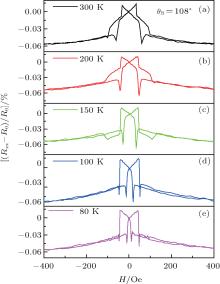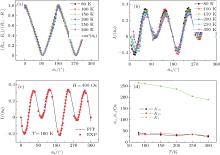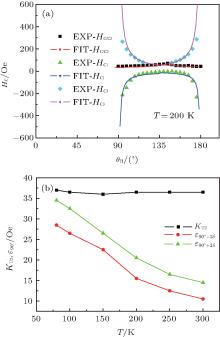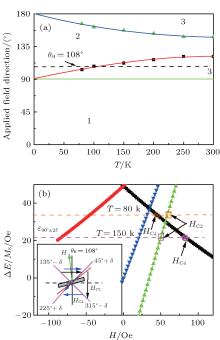†Corresponding author. E-mail: zhcheng@iphy.ac.cn
*Project supported by the National Basic Research Program of China (Grant Nos. 2015CB921403, 2011CB921801, and 2012CB933102) and the National Natural Science Foundation of China (Grant Nos. 51427801, 11374350, and 11274361).
Temperature dependence of magnetic switching processes with multiple jumps in Fe/MgO (001) films is investigated by magnetoresistance measurements. When the temperature decreases from 300 K to 80 K, the measured three-jump hysteresis loops turn into two-jump loops. The temperature dependence of the fourfold in-plane magnetic anisotropy constant K1, domain wall pinning energy, and an additional uniaxial magnetic anisotropy constant KU are responsible for this transformation. The strengths of K1 and domain wall pinning energy increase with decreasing temperature, but KU remains unchanged. Moreover, magnetization reversal mechanisms, with either two successive or two separate 90° domain wall propagation, are introduced to explain the multi-jump magnetic switching process in epitaxial Fe/MgO(001) films at different temperatures.
The magnetization reversal process is crucial when using Fe films for spintronic applications.[1, 2] Although Fe(001) film usually exhibits an intrinsic in-plane fourfold magnetic anisotropy, an additional uniaxial magnetic anisotropy (UMA)[3, 4] is always superimposed owing to the surface steps of substrates, [5] oblique deposition, [6] or dangling bonds.[7] Depending on the strengths of the fourfold magnetic anisotropy constant K1, UMA constant KU, and domain wall pinning energy, hysteresis loops will present one-, two-, and three-jump magnetic switching processes. When KU/K1 < 1, two-jump loops are observed.[8, 10] If the value of KU is larger than 90° , with domain wall pinning energy at the same time, three-jump loops will be present at some directions of applied field. These magnetic switching processes can be understood by 90° domain wall nucleation. It is especially interesting that the one-jump process is also explained by two successive 90° domain wall nucleations instead of 180° domain wall nucleation, as was investigated by Zhan et al.[11, 12] But the temperature dependence of magnetic hysteresis loops with multiple jumps has been investigated little, even though it is important for the performance of magnetic media, random access memory, and the dynamic response of films. In our work, the pronounced UMA induced by oblique-incidence growth results in three-jump hysteresis loops in some directions of field in Fe/MgO (001) system. Moreover, these three-jump loops can transform into two-jump loops with decreasing temperature. The K1, KU, and domain wall pinning energy are researched by magnetoresistance (MR) measurements[13, 14] at different temperatures to explain this transformation.
The Fe/MgO (001) films were deposited by molecular-beam epitaxy (MBE) in an ultrahigh vacuum (UHV) system with a base pressure of 2.0 × 10− 10 mbar. The MgO (001) substrates were first heat treated at 700 ° C for 2 h to obtain clean surfaces. The 30 monolayer (ML) Fe films with a deposition rate of 1.5 ML/min were grown by oblique-incidence deposition at room temperature. The incident Fe beam was at an angle of 10° with respect to the surface normal and with azimuthal angle along Fe [100] direction. Moreover, 25 ML Cu films were deposited as protective layers. The magneto– optical Kerr effect (MOKE) and MR measurements were used to research magnetic properties of film. The stable temperature is obtained using the LakeShore 340 temperature controller (stability < 0.01 ° C/h) in the measurement. The MR measurements were performed with a standard four-point method at different temperatures, and the details are described in Ref. [14].
The schematic configuration of the magnetic anisotropy and the coordinate system are shown in Fig. 1(a), which is used in our MOKE measurement and data analysis. Based on the orientation of the additional in-plane UMA, the UMA along the hard axis of cubic magnetic anisotropy is defined as KU1, which will be investigated in our other work of Fe (001) film grown at normal incidence geometry. Another UMA along Fe [100] originating from oblique-incidence growth geometry is defined as KU2. It is perpendicular to the incident flux direction and results from the self-shadowing effect. The different directions of UMA can result in different magnetic switching processes. The UMA along Fe 

The UMA along Fe [100] is important to create a multi-jump magnetic switching process. Zhan’ s experimental results reveal that one considerable UMA along [100] can result in three-jump loops at some directions of external magnetic field.[11, 16] These multi-jump loops were also observed in our sample with two considerable UMA in our work as illustrated in Fig. 1(b) one jump at θ H = 9° , two jumps at θ H = 135° , and three jumps at θ H = 162° given by typical MOKE; θ H is the angle of applied field from [110] hard axis. According to the 90° domain wall magnetization reversal mechanism, [16] magnetization from [100] to 




Compared with MOKE measurement, MR measurement has many advantages, such as high sensitivity in magnetic anisotropy energy, [14] and no surface smoothness requirements.[13] So the MR measurement equipped with temperature controller is a good method to investigate the temperature dependence of multi-jump magnetic switching process. In our previous work, the orientation of current is not strictly along [110] and has deviation as shown in inset of Fig. 2(a), which can distinguish the magnetization along the two easy axes. So the multi-jump switching process can also be revealed in MR measurement. For the Fe film, one-jump, two-jump or three-jump loops are observed respectively at different angles of applied field, as illustrated in Fig. 2 [one-jump at θ H = 9° (Fig. 2(a)), two-jump at θ H = 135° (Fig. 2(b)), and three-jump at θ H = 162° (Fig. 2(c))], which correspond to typical longitudinal MOKE measurements. We define the switching fields for the one-jump (HC), for the two-jump (we refer to the first switching field as HC1 and to the second switching field as HC2) and for the three-jump (we refer to the first switching field as HC1, to the second switching field as HC, and to the last switching field as HC3, respectively) loops as shown in Fig. 2.
 | Fig. 2. Typical MR loops for film with (a) one-jump at θ H = 9° , (b) two-jump at θ H = 135° , and (c) three-jump at θ H = 162° corresponding to typical longitudinal MOKE measurements of Fig. 1. The orientation of current relative to the [110] is indicated in the inset of panel (a). The black (red) curves are for external magnetic field varying from negative (positive) to positive (negative) saturation. |
The MR loops at θ H = 108° are measured at different temperatures (300 K– 80 K) as shown in Fig. 3. Three-jump switching process is observed at 300 K. But the magnetic hysteresis loops turn into two-jump loops when the temperature decreases. This transformation can be well understood in terms of a competition of the cubic anisotropy K1, the extra UMA (KU1, KU2), and domain wall pinning energy.[11, 12, 16]
 | Fig. 3. MR loops for film of θ H = 108° at different temperatures: (a) 300 K, (b) 200 K, (c) 150 K, (d) 100 K, and (e) 80 K. |
In order to figure out K1, KU1, and KU2, the angular dependence of anisotropy magnetoresistances at high field of 400 Oe were measured at different temperatures, as shown in Fig. 4(a). The MR can be expressed as:[14, 17– 20]

Here, θ M and α = 6.3° are angles of magnetic moment M and current, measured from the Fe[110] direction. The maximum value R/ / and minimum value R⊥ correspond to MR when H is parallel and perpendicular to the direction of current, respectively. The values of MR show a periodically oscillating behavior following the orientation of the external field. However, due to the magnetic anisotropy, M is no longer kept along with the external field H during rotation, i.e. the angular-dependent MR curves do not follow the cos2(θ H − α ) relationship. The values of θ M can be obtained by analyzing the MR curves on the basis of Eq. (1). Moreover, the magnetic torque can be expressed as L(θ M) = μ 0MSH sin(θ H − θ M), and the normalized magnetic torque l(θ M) = L(θ M)/μ 0MSH = sin(θ H − θ M) can be obtained at different temperatures, as illustrated in Fig. 4(b).
Considering the magnetic field is large enough to guarantee a single domain rotation in the Fe/MgO(001) system, the total energy including the magnetic anisotropy energy and Zeeman energy can be expressed as

In equilibrium state ∂ E/∂ θ M = 0, the normalized magnetic torque is as follows:

It can be easily seen that the l(θ M) shows superposition of two UMA and fourfold magnetic anisotropies, as shown Fig. 4(c). Taking an example of the curve measured at T = 100 K, magnetic torque curve is fitted using Eq. (3) to get the magnetic anisotropy constants K1, KU1, and KU2. These parameters at other temperatures can be obtained similarly as shown in Fig. 4(d). The results show K1 decreases with increasing temperature, while KU1 and KU2 remain unchanged. The fourfold magnetic anisotropy originates from magnetocrystalline anisotropy, which is interactions of the spontaneous magnetization and lattice. The spontaneous magnetization decreases with increasing temperature, which makes the value of K1 also decrease. Moreover, the UMA results from shape anisotropy in our experiment, so the value of it is less influenced by the temperature.
Already, the 90° domain wall displacement has been introduced to interpret the multi-jump magnetic switching process.[16] The strength of the domain wall pinning energy can be determined by fitting the angular dependence of the switching fields.[15] We measured the switching fields (HC, HC1, HC2, and HC3) as a function of the angle θ H at 4.5° interval for the Fe layers at different temperatures, and obtained a behavior similar to the one presented in Fig. 5(a) for the temperature T = 200 K.
The domain wall pinning energy can be derived from the equations of theoretical switching fields[21]



Due to KU1, the minima of total energy (Eq. (3)) are located at 45° + δ , 135° − δ , 225° + δ , and 315° − δ . Because the angle between two neighboring easy axes in the system is either 90° − 2δ or 90° + 2δ , the magnetization transitions in the multi-jump process are mediated by sweeping of 90° − 2δ or 90° + 2δ domain walls corresponding to domain wall pinning energies ε 90° − 2δ and ε 90° + 2δ .
The experimental results of switching fields HC, HC1, HC2, and HC3 can be fitted well using the theoretical Eqs. (4)– (6), as illustrated in Fig. 5(a). On the basis of Zhan’ s results, the 180° magnetic transitions (HC) can be understood by the fact that they consist of two successive 90° magnetic transitions; one is at HC2 and another 90° magnetic transition immediately follows at the same field HC2.[11, 12] This indicates that the theoretical expression for HC2, which corresponds to a 90° DW nucleation, allows us to nicely fit the HC data. By fitting observed switching fields at different temperatures, the temperature dependence values of KU2, ε 90° − 2δ , and ε 90° + 2δ are obtained, as shown in Fig. 5(b). The results show that the UMA constant KU2 is independent of temperature and keeps constant, which is consistent with the MR results. But the values of domain wall pinning energies ε 90° − 2δ and ε 90° + 2δ both decrease largely from 35 Oe to 10 Oe and 30 Oe to 8 Oe, respectively, when the temperature increases from 80 K to 300 K.
By analyzing the angle θ H of Fe layers with one-, two-, and three-jump loops at different temperatures, the range of these multi-jump loops varies, as illustrated in Fig. 6(a). The number represents the type of switching process. When the temperature increases, the range of loops with one jump keeps constant. The two-jump loops turn into three-jump loops, and their range becomes narrow. So the loops with two and three jumps are greatly dependent upon temperature. In order to research this transformation, the 90° domain-wall pinning energies and total energy of Fe (001) system obtained in previous analysis were introduced.
Based on the obtained values of KU1, KU2, K1, and total energy Eq. (2), figure 6(b) shows in the energy differences Δ E135° − δ → 45° + δ (blue), Δ E315° − δ → 225° + δ (black), Δ E225° + δ → 315° − δ (red), and Δ E45° + δ → 315° − δ (green) as a function of the applied field in direction θ H = 108° (dashed lines in Fig. 6(a)). On the basis of Ref. [16], the two-jump switching process at θ H = 108° corresponds to magnetization switching from 135° − δ to 45° + δ and 45° + δ to 315° − δ by two separate 90° domain wall nucleations as shown in inset of Fig. 6(b) (black arrow). But in three-jump switching process (135° − δ to 45° + δ to 225° + δ to 315° − δ blue arrow), the magnetization switching between 45° + δ and 225° + δ should overcome two energy barriers (45° + δ → 315° − δ ) and (315° − δ → 225° + δ ) by means of two successive 90° domain wall nucleations. So we plot the energy differences between these directions as a function of the applied field.
Corresponding to two different 90° domain wall nucleation processes, we focus on the two energy barriers (45° + δ → 315° − δ ) and (315° − δ → 225° + δ ) that guide the magnetization switching process. The switching field HC2 is determined by the energy barrier for the transition Δ E45° + δ → 315° − δ = ε 90° + 2δ . The other energy barrier Δ E315° − δ → 225° + δ decreases with increasing applied field and becomes ε 90° − 2δ (which is close to ε 90° + 2δ ) at HC4 (as shown in Fig. 6(b)). Based on the results of Ref. [16], when HC4 > HC2, the domains along 315° − δ are unstable and cannot grow; the magnetization switching is from 45° + δ to 225° + δ directly. So, the magnetic loops will present a three-jump loop (135° − δ to 45° + δ to 225° + δ to 315° − δ ) by two successive domain wall nucleations. Otherwise, when HC2 > HC4, the domains along 315° − δ are stable and can grow; the magnetization switching is from 45° + δ to 315° − δ and magnetic loops present two-jump loops (135° − δ to 45° + δ to 315° − δ ) by two separate 90° domain wall nucleations. Taking T= 80 K and 150 K for example, the values of ε 90° − 2δ and ε 90° + 2δ decrease with increasing temperature, which makes the relationship HC2 > HC4 turn into HC2 < HC4. So the transformation of two-jump loop into three-jump loop appears.
Fe/MgO (001) films with one-, two-, and three- jump magnetic switching processes were fabricated. The magnetic hysteresis loops with two-jump change into three-jump loops with increasing temperature. This can be explained by temperature dependence of magnetic anisotropy energy and domain wall pinning energy. The fourfold in-plane magnetic anisotropy energy (K1), two additional UMA energy (KU1, KU2), and domain-wall pinning energies were obtained by MR measurements. As the temperature decreases, the values of K1 and domain wall pinning energies increase, but KU1 and KU2 remain largely unchanged. These temperature dependencies of parameters make the reversal mechanism from two successive 90° domain-wall propagations turn into two separate domain-wall propagations.
| 1 |
|
| 2 |
|
| 3 |
|
| 4 |
|
| 5 |
|
| 6 |
|
| 7 |
|
| 8 |
|
| 9 |
|
| 10 |
|
| 11 |
|
| 12 |
|
| 13 |
|
| 14 |
|
| 15 |
|
| 16 |
|
| 17 |
|
| 18 |
|
| 19 |
|
| 20 |
|
| 21 |
|






